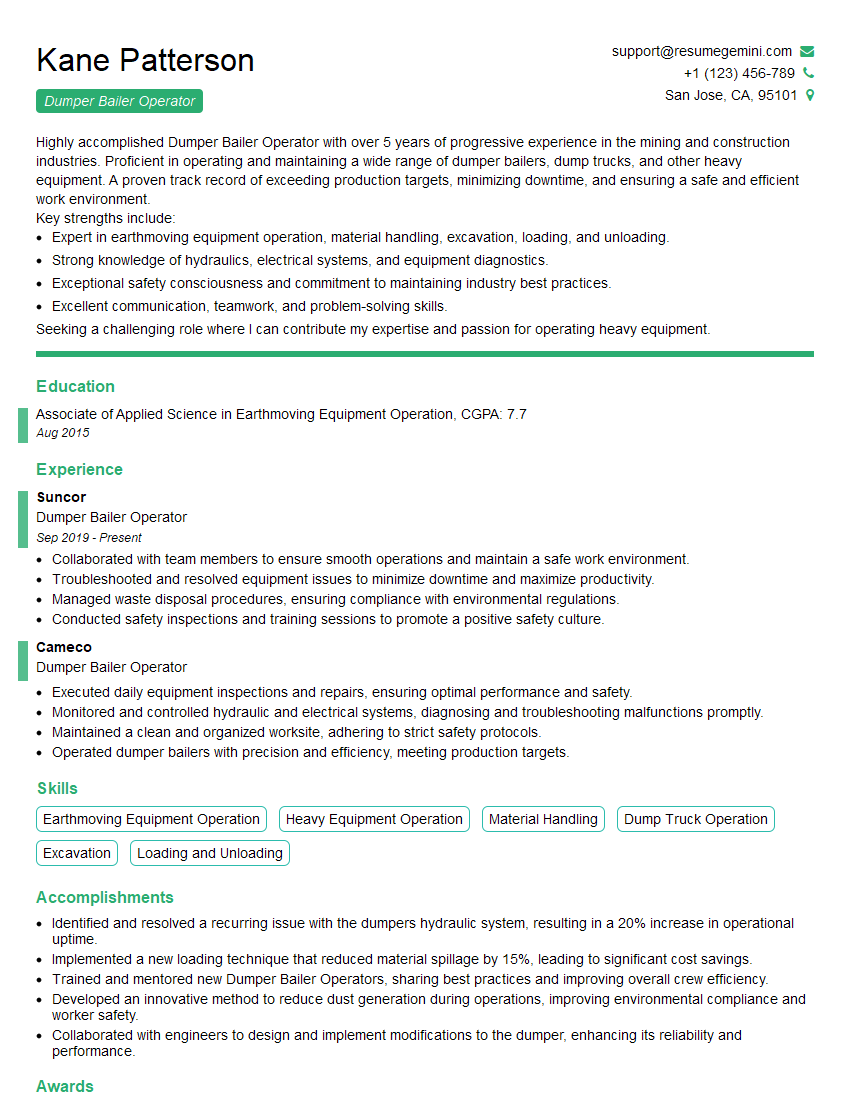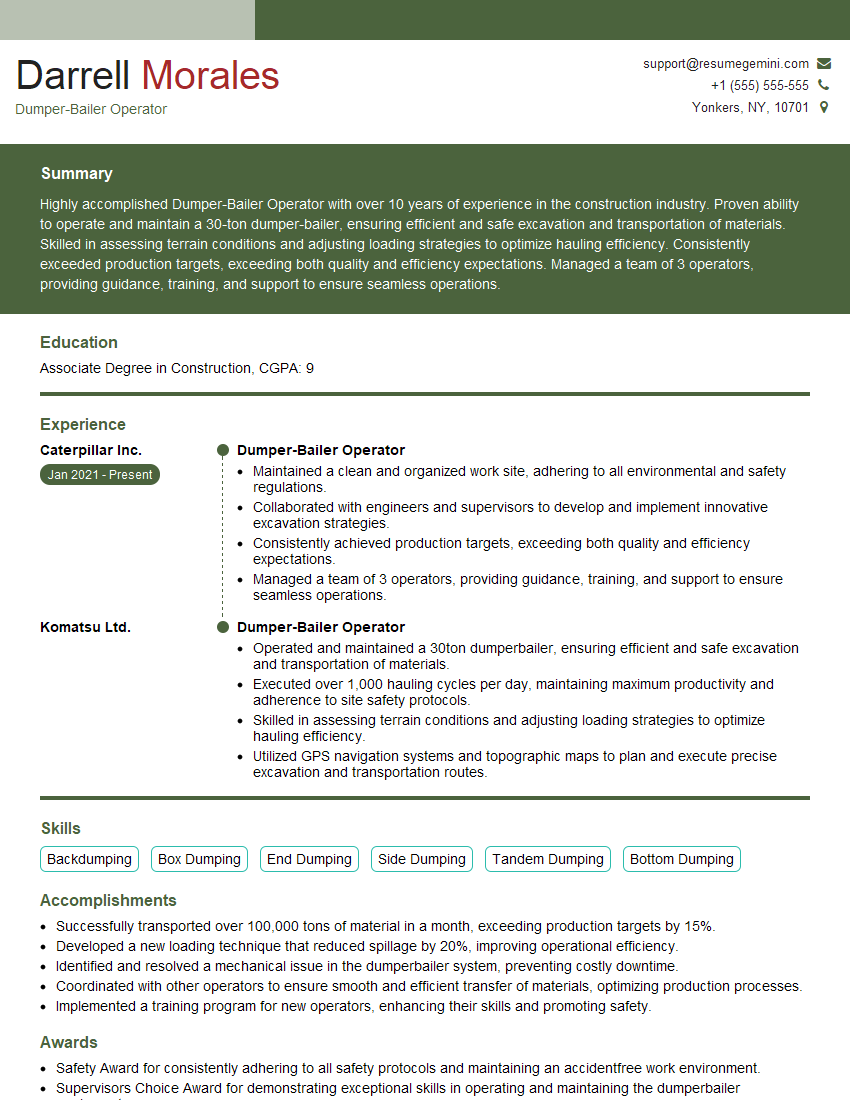Ever felt underprepared for that crucial job interview? Or perhaps you’ve landed the interview but struggled to articulate your skills and experiences effectively? Fear not! We’ve got you covered. In this blog post, we’re diving deep into the Dumper Bailer Operator interview questions that you’re most likely to encounter. But that’s not all. We’ll also provide expert insights into the key responsibilities of a Dumper Bailer Operator so you can tailor your answers to impress potential employers.
Acing the interview is crucial, but landing one requires a compelling resume that gets you noticed. Crafting a professional document that highlights your skills and experience is the first step toward interview success. ResumeGemini can help you build a standout resume that gets you called in for that dream job.
Essential Interview Questions For Dumper Bailer Operator
1. What is the purpose of a dumper bailer?
A dumper bailer is used to transport and dump materials, such as soil, rocks, and waste, from one location to another. It typically consists of a large, open container mounted on a truck chassis and a hydraulic ram that lifts and dumps the container.
2. What are the key safety precautions to observe when operating a dumper bailer?
Before operating the dumper bailer:
- Inspect the equipment for any damage or defects.
- Ensure that the work area is clear of obstacles and personnel.
- Wear appropriate safety gear, including a hard hat, safety glasses, and gloves.
During operation:
- Maintain a safe distance from other vehicles and objects.
- Avoid operating the dumper bailer on slopes or uneven surfaces.
- Be aware of overhead obstacles and power lines.
- Dump the load slowly and carefully to avoid spills or accidents.
3. How do you determine the correct capacity for a dumper bailer?
The correct capacity for a dumper bailer depends on the specific materials being transported and the distance and terrain involved. Factors to consider include the weight and volume of the materials, the slope and condition of the haul route, and the desired cycle time. It is important to consult with the manufacturer or a qualified engineer to determine the optimal capacity for the specific application.
4. What are the different types of dumper bailers available?
There are several types of dumper bailers available, each designed for specific applications. Common types include:
- Rear-eject dumpers: These dumpers have a container that tilts backward to discharge the load.
- Side-eject dumpers: These dumpers have a container that tilts to the side to discharge the load.
- Bottom-eject dumpers: These dumpers have a container with a door or gate that opens at the bottom to discharge the load.
- Combination dumpers: These dumpers can discharge the load from multiple sides or directions.
5. What is the proper procedure for loading a dumper bailer?
- Position the dumper bailer under the loading device (e.g., excavator, conveyor).
- Ensure that the loading device is stable and secure.
- Load the material into the dumper bailer evenly, avoiding overloading.
- Secure the load with tarps or other coverings if necessary.
6. How do you handle a dumper bailer that becomes stuck or immobile?
If a dumper bailer becomes stuck or immobile, it is important to remain calm and assess the situation. Do not attempt to move the dumper bailer until you have ensured that it is safe to do so. Steps to take include:
- Identify the cause of the problem (e.g., soft ground, obstacle, mechanical failure).
- Call for assistance from a supervisor or qualified mechanic.
- Use caution when attempting to free the dumper bailer, as sudden movements could cause further damage or injury.
7. What are the common maintenance tasks required for a dumper bailer?
- Regular inspections for leaks, damage, or wear and tear.
- Lubrication of moving parts, such as hinges and hydraulic cylinders.
- Tire inspections and maintenance.
- Battery maintenance and charging.
- Hydraulic system inspections and fluid changes.
8. How do you troubleshoot a dumper bailer that is not lifting or dumping properly?
Troubleshooting a dumper bailer that is not lifting or dumping properly involves a systematic approach to identify and address the underlying issue. Steps may include:
- Checking the hydraulic system for leaks, low fluid levels, or faulty components.
- Inspecting the lifting and dumping mechanisms for mechanical damage or obstructions.
- Verifying that the electrical system is functioning correctly.
- Consulting the manufacturer’s manual or seeking assistance from a qualified mechanic.
9. What is the importance of following proper operating procedures when using a dumper bailer?
Following proper operating procedures when using a dumper bailer is crucial for ensuring safety, efficiency, and the longevity of the equipment. These procedures typically cover aspects such as:
- Safe loading and unloading practices.
- Proper use of controls and indicators.
- Maintaining a safe distance from other vehicles and personnel.
- Adhering to speed limits and traffic regulations.
10. How do you prioritize safety when operating a dumper bailer in a work zone?
Prioritizing safety when operating a dumper bailer in a work zone involves implementing various measures to minimize risks and protect individuals in the area. These measures may include:
- Wearing appropriate personal protective equipment (PPE).
- Establishing clear communication protocols with other workers and supervisors.
- Maintaining a safe distance from other equipment and personnel.
- Being aware of potential hazards and taking steps to avoid them.
- Following established safety protocols and regulations.
Interviewers often ask about specific skills and experiences. With ResumeGemini‘s customizable templates, you can tailor your resume to showcase the skills most relevant to the position, making a powerful first impression. Also check out Resume Template specially tailored for Dumper Bailer Operator.
Career Expert Tips:
- Ace those interviews! Prepare effectively by reviewing the Top 50 Most Common Interview Questions on ResumeGemini.
- Navigate your job search with confidence! Explore a wide range of Career Tips on ResumeGemini. Learn about common challenges and recommendations to overcome them.
- Craft the perfect resume! Master the Art of Resume Writing with ResumeGemini’s guide. Showcase your unique qualifications and achievements effectively.
- Great Savings With New Year Deals and Discounts! In 2025, boost your job search and build your dream resume with ResumeGemini’s ATS optimized templates.
Researching the company and tailoring your answers is essential. Once you have a clear understanding of the Dumper Bailer Operator‘s requirements, you can use ResumeGemini to adjust your resume to perfectly match the job description.
Key Job Responsibilities
A Dumper Bailer Operator is responsible for operating dumper bailer machines, which are used to collect and transport waste materials. They work in a variety of settings, including construction sites, landfills, and recycling centers.
1. Operating Dumper Bailer Machines
Dumper Bailer Operators are responsible for the safe and efficient operation of dumper bailer machines. This includes:
- Loading and unloading waste materials
- Operating the machine’s controls
- Maintaining the machine
2. Inspecting Waste Materials
Dumper Bailer Operators inspect waste materials to ensure that they are suitable for disposal. They look for hazardous materials, recyclables, and other items that may need to be separated.
- Identifying hazardous materials
- Separating recyclables
- Removing non-disposable items
3. Maintaining Work Area
Dumper Bailer Operators are responsible for maintaining a clean and safe work area. This includes:
- Cleaning the machine
- Keeping the work area free of debris
- Inspecting the work area for hazards
4. Following Safety Procedures
Dumper Bailer Operators must follow all safety procedures to ensure the safety of themselves and others. This includes:
- Wearing appropriate safety gear
- Following lockout/tagout procedures
- Reporting any accidents or injuries
Interview Tips
Preparing for an interview for a Dumper Bailer Operator position can be a daunting task, but with the right preparation, you can increase your chances of success. Here are a few tips to help you ace your interview:
1. Research the Company and the Position
Before your interview, take some time to research the company and the position you are applying for. This will help you understand the company’s culture, values, and goals, and it will also help you answer questions about your qualifications and experience. You can find information about the company on its website, social media pages, and in news articles. You can also find information about the position by reading the job description and talking to people who work in the industry.
2. Practice Answering Common Interview Questions
There are a number of common interview questions that you are likely to be asked, such as “Tell me about yourself” and “Why are you interested in this position?” It is helpful to practice answering these questions in advance so that you can deliver your answers confidently and concisely. You can practice answering these questions with a friend or family member, or you can record yourself answering the questions and then listen back to your answers.
3. Be Prepared to Talk About Your Skills and Experience
The interviewer will want to know about your skills and experience, so be prepared to talk about your qualifications in detail. Be sure to highlight your experience operating dumper bailer machines, as well as your knowledge of waste disposal procedures. You should also be prepared to talk about your safety record and your ability to work in a team environment.
4. Dress Professionally and Arrive on Time
First impressions matter, so it is important to dress professionally for your interview. You should also arrive on time for your interview, which shows that you are respectful of the interviewer’s time.
Next Step:
Now that you’re armed with interview-winning answers and a deeper understanding of the Dumper Bailer Operator role, it’s time to take action! Does your resume accurately reflect your skills and experience for this position? If not, head over to ResumeGemini. Here, you’ll find all the tools and tips to craft a resume that gets noticed. Don’t let a weak resume hold you back from landing your dream job. Polish your resume, hit the “Build Your Resume” button, and watch your career take off! Remember, preparation is key, and ResumeGemini is your partner in interview success.

